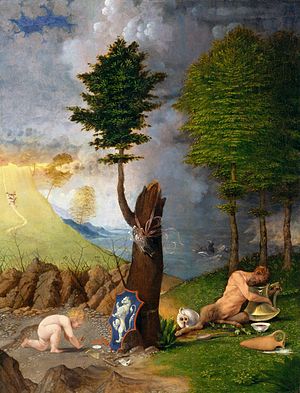Monday, May 21, 2012
Italian Renaissance Master Lorenzo Lotto
The first U.S. exhibition of paintings by Italian Renaissance master Lorenzo Lotto (c.1480 - 1556/1557) was presented this fall at the National Gallery of Art. Lorenzo Lotto: Rediscovered Master of the Renaissance, on view November 2, 1997 - March 1, 1998, will include fifty works by this fascinating artist, whose work is not sufficiently well known in the United States. Lotto's portraits, allegories, and religious paintings, with their brilliant color and arresting details, have an idiosyncratic character not usually associated with the Renaissance. Many of the paintings in the show were lent by churches and museums in the picturesque locations in Italy where Lotto originally worked.
The exhibition was organized by the National Gallery of Art, in association with the Accademia Carrara di Belle Arti, Bergamo, one of the premier repositories of Lotto's work. The National Gallery of Art will be the only venue in the United States. After its Washington showing, the exhibition traveled to the Accademia Carrara in Bergamo (April 2 - June 28, 1998), as part of the museum's 200th anniversary celebration, and to the Galeries nationales d'Exposition of the Grand Palais/Musée du Louvre, Paris (October 12, 1998 - January 11, 1999).
"Lotto's pictures never fail to intrigue viewers. Since Bernard Berenson's pioneering monograph on Lorenzo Lotto first appeared in 1895, the artist and his work have had a special appeal for twentieth-century sensibilities," said Earl A. Powell III, director, National Gallery of Art. "These paintings will be new to many, who have yet to discover the beauties of Bergamo, Recanati, Jesi, and the other Lotto sites, which are off the beaten track for tourists." Also unfamiliar to some viewers will be two works by the artist being lent from Krakow, Poland, and Bucharest, Romania.
Portraits
Today, Lotto is most appreciated for the probing, psychological character of his portraits. Outstanding examples shown in the exhibition included
a. the likeness of the antiquities collector Andrea Odoni (1527), lent by Her Majesty Queen Elizabeth II;
b.the strikingly bold Portrait of a Lady as Lucretia (c. 1533) from London's National Gallery; and
c. the melancholic Portrait of a Young Man (c. 1530) from the Gallerie dell'Accademia, Venice.
These portraits of single individuals, surrounded by symbols in unusual settings, were complemented by a pair of extraordinary marriage portraits from the Prado Museum, Madrid, and from The State Hermitage Museum, St. Petersburg.
Allegories and Religious Paintings
Among the other masterworks included in the exhibition were a. the National Gallery of Art's Allegory of Virtue and Vice (1505) and
b.Allegory of Chastity (c. 1506).
These small works were reunited for the first time in almost five hundred years with Lotto's portraits from Naples and Dijon, for which they originally served as covers. Similarly poetic is the Saint Jerome in the Wilderness (1506?) with its idyllic landscape from the Musée du Louvre, Paris.
Larger-scale religious compositions include the richly colored Mystic Marriage of Saint Catherine (1523) from the Accademia Carrara di Belle Arti, Bergamo; the sensitively painted Virgin and Child with Saints Catherine of Alexandria and Thomas (c. 1528-1530) from the Kunsthistorisches Museum, Vienna; and the visionary altarpiece of the Virgin and Child Enthroned with Saints (1521) from the Church of Santo Spirito, Bergamo. The last two works, among many others, have recently been conserved for the exhibition.
The intensely dramatic Christ Carrying the Cross (1526) from the Louvre and the Annunciation (c. 1534-1535) from the Pinacoteca Civica in the town of Recanati both reveal the depth of Lotto's religious feelings. An itinerant artist who forsook worldy pleasures, Lotto particularly identified with Saint Jerome, the reputed founder of Western monasticism, and no fewer than five of his depictions of this saint were included in the exhibition.
Catalogue
Accompanying the exhibition was a fully illustrated catalogue, Lorenzo Lotto: Rediscovered Master of the Renaissance, with color images of every painting in the show. The catalogue offered a comprehensive account of the artist's achievement with essays by a wide range of international experts, along with detailed entries on the works exhibited. A comprehensive bibliography and a chronology are also included. The English edition of the catalogue was published by the National Gallery of Art and distributed by Yale University Press, New Haven and London. An Italian edition was published by Skira, Milan.


